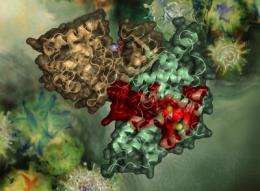Insight into structure of HIV protein could aid drug design

Researchers at the University of Iowa Carver College of Medicine and University of Nebraska Medical Center (UNMC) have created a three-dimensional picture of an important protein that is involved in how HIV -- the virus responsible for AIDS -- is produced inside human cells. The picture may help researchers design drugs that can prevent HIV from reproducing.
The research team, led by David Price, Ph.D., UI professor of biochemistry, and Tahir Tahirov, Ph.D., professor of structural biology at the Eppley Institute at UNMC, combined expertise in protein chemistry and X-ray crystallography -- a technique for observing protein structures -- to produce the first crystal structure of the HIV protein called Tat. The structure shows Tat attached to the human protein (P-TEFb) that the virus hijacks during infection.
The structure shows how Tat latches on to this particular human protein and how the interaction alters the shape of the human protein. The study is published in the June 10 issue of the journal Nature.
"We have solved the long sought-after structure of an important HIV protein," Price said. "Now that we know the details of the interaction between Tat and P-TEFb, it may be possible to design inhibitors that target P-TEFb only when it is interacting with Tat."
This distinction is important because although inhibiting P-TEFb blocks replication of the HIV virus, P-TEFb is a vital protein in human cells and inhibiting it kills cells. If an inhibitor could be designed that distinguishes between the P-TEFb attached to Tat and the form that is normal in human cells, that drug might target HIV replication without harming normal cell function.
Such compounds could be useful in combination with existing anti-HIV drugs to further reduce viral levels in HIV-infected individuals.
In addition, drugs that target P-TEFb may also be useful in treating drug-resistant HIV, which is a growing problem. The HIV virus mutates very easily and can develop resistance to current drug that target viral proteins. Targeting a human protein like P-TEFb that the virus needs but cannot mutate may be a successful strategy to counter drug-resistant HIV.
















